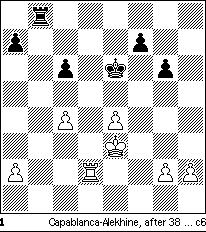
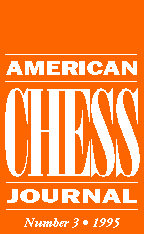
Capablanca--Alekhine, New York 1924
French Defense C12
1 d4 e6 2 e4 d5 3 Nc3 Nf6 4 Bg5 Bb4 5 exd5 Qxd5 6 Bxf6 Bxc3+ 7 bxc3 gxf6
8 Qd2 Nd7 9 c4 Qe4+ 10 Ne2 Nb6 11 f3 Qc6 12 c5 Nd5 13 c4 Ne7 14 Nc3 f5 15
Be2 Rg8 16 0-0 Bd7 17 Qe3 b6 18 Rfd1 bxc5 19 d5 Qd6 20 dxe6 Qxe6 21 Qxc5
Qb6 22 Qf2 f4 23 Rab1 Qxf2+ 24 Kxf2 Bc6 25 Rd4 Ng6 26 Bd3 Nh4 27 Bf1 Ng6
28 Ne2 Ke7 29 Re1 Rgb8 30 Nxf4+ Kf8 31 Nxg6+ hxg6 32 Bd3 Rb2+ 33 Re2 Rab8
34 Be4 Rxe2 35 Kxe2 Bxe4 36 fxe4 Ke7 37 Rd2 Ke6 38 Ke3 c6 (D 1)

White to move. He has an extra pawn, but realizing this advantage is not simple. (Remember the half-joking, half-serious aphorism of Tarrasch, "Rook endings are never won.") Let's take a look at the candidate moves in the position. It is useful at the start to look for the larger ideas -- otherwise, you overload yourself too early with calculations, and you miss something important.
The move 39 c5 springs to mind. It threatens 40 Rd6+, winning the pawn on c6. A second suggestion is 39 Kd4, in the hope of getting the king to c5. Still another plan is 39 h4 with the idea of 40 g4, 41 Rh2, etc. The white rook will occupy an ideal position behind the passed h-pawn.
As you see, White has several tempting possibilities. If we are to make a reliable choice, we must consider the opponent's counterplay.
Let's go in order, starting with 39 c5. On 39 ... Ke5?! follows 40 Rd7. In the case of 39 ... Rb4?! nothing comes of 40 Rd6+ Ke5 41 Rxc6 Rxe4+ and 42 ... Ra4. On the other hand, much better is 40 Kf4! with the followup 41 Rd6+. Alekhine showed the best defense: 39 ... Rb5! 40 Rd6+ Ke5 41 Rxc6 (41 Rd7 Ra5 or 41 ... Rxc5) 41 ... Ra5 (D 2),
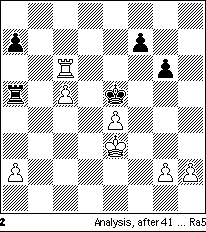
followed by 42 ... Ra3+, 43
... Rxa2+ ... With such growing piece activity, Black will not lose.
Let's take a look at 39 Kd4. Obviously the king cannot be let into c5. It doesn't help to play 39 ... Kd6? 40 e5+, so the reply 39 ... Rd8+ is forced. After 40 Kc3 the threat c4-c5 becomes more serious, because the c5 pawn can be defended by the king. Nevertheless, White's idea is not hard to counter: 40 ... Rh8! 41 h3 Rh5 (D 3) (also deserving attention is 41 ... Rh4).
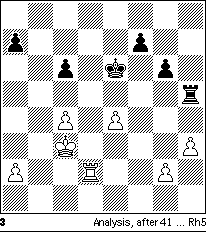
The
rook is exceptionally well placed on the fifth rank, where it controls the
square c5 (if 42 Kb4, then 42 ... a5+) and is able to attack any enemy pawn.
It is clear that White has achieved nothing.
The move 39 h4 still needs to be checked. The answer 39 ... Rh8! suggests itself (bad is 39 ... f5? 40 exf5+). White plays 40 g3, preparing 41 Rh2 and 42 g4. How can this plan be countered? The same maneuver of the rook saves everything: 40 ... Rh5! 41 Rh2 Ra5! (D 4).
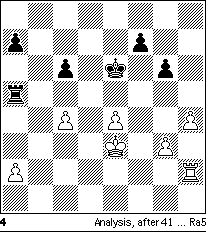
Now 42 g4? is unprofitable
because of 42 ... Ke5 43 h5 Ra3+ and 41 ... Rxa2+. And on 42 Kf4 follows
42 ... f6, preparing in case of g3-g4 to exchange the opponent's most dangerous
pawn with g6-g5+!
By straightforwardly pursuing any of the plans we laid out, White achieves
nothing. So how should he continue to play for a win? Note carefully that
Black saves himself everywhere by moving the rook to the fifth rank. So
let's think about prevention -- let's try hindering the main defensive idea
of our opponent.
Alekhine suggests the surprising move 39 h3!! Now in the case of 39 ...
Rh8 the h-pawn is not hanging and White answers 40 c5. After 40 ... Rh4,
White gets no significant advantage by 41 Rd6+ Ke5 42 Rxc6 Rxe4+ and 43
... Ra4, but very strong is 41 Rd8! At the same time, Black now has to consider
the serious threat 40 Kd4. For example: 39 ... Rb1(b4) 40 Kd4 Kd6 41 e5+,
or 39 ... f6 40 Kd4 Rd8+ (40 ... Kd6 41 c5+ Ke6 42 Kc4) 41 Kc3 Rb8 42 c5
Ke5 43 Rd6 with an obvious advantage. It's dangerous to play 39 ... Ke5
because of 40 Rd7. There remains 39 ... c5 40 Rd5 (if 40 h4, then 40 ...
Rb4!, but not 40 ... Rh8 41 g3 Rh5 42 Rh2, and the fifth rank has become
too short) 40 ... Rb2 41 g4 (also good is 41 Rxc5 Rxg2 42 Ra5) 41 ... Rxa2
42 Rxc5 Ra3+ 43 Kd4 Rxh3 44 Ra5 with excellent chances for White to win.
It is characteristic that Capablanca, a genius of chess intuition, doesn't manage to make the correct decision here. Alekhine is a chessplayer of a totally different frame of mind. A move like 39 h3!! cannot be made intuitively from "general impressions." It can only be found by a concrete investigation of the depths of the position.
Many years ago I helped Botvinnik lead an exercise in his school. At the request of Mikhail Moiseevich I prepared a large endgame exercise for the young Garry Kasparov, which included independent analysis of this Capablanca-Alekhine endgame. Garry found still another method to interfere with Black's bringing the rook to the fifth rank, the move 39 g3!! I like it very much, perhaps even more than the move recommended by Alekhine, because it contains the active follow-up idea 40 h4! And there don't appear to be any minuses. For example, if 39 ... g5, there is the pleasant choice between 40 h4 and 40 Rf2 with the threats 41 Rf5 or 41 Kd4. Further, if 39 ... Rh8 40 c5 Rh5 41 Rd6+ Ke5 (41 ... Ke7 42 Rxc6 Rxh2 43 Ra6) 42 h4 with advantage to White.
Now let's look at how the game proceeded.
39 h4?! Rh8 40 g3 Rh5! 41 Rh2 Ra5 42 Kf4
42 g4? Ke5; 42 Kd4? c5+.
42 ... f6! (D 5)
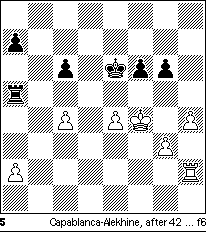
The main danger has been removed. If 43 g4 there is the answer 43 ... g5+!
The game takes on a maneuvering character. Capablanca knew how to put one
problem after another in front of his opponent, so Alekhine had to put up
an exceptionally careful defense.
43 Rc2 Re5
Otherwise after 44 c5 the rook would be cut off from the kingside and couldn't
interfere with White's playing g3-g4 and h4-h5.
44 c5
A double-edged move, but otherwise he can't improve his position. White
limits the mobility of the enemy rook, but his own rook will be bound to
the pawn on c5.
44 ... Rh5 45 Rc3
Threatening an advantageous exchange of pawns: 46 Ra3 Rxc5 47 Rxa7.
45 ... a5! 46 Rc2 Re5 47 Rc3 Rh5 48 Kf3! Ke7!
Mistaken would be 48 ... Ke5? 49 Ra3 or 48 ... Re5? 49 g4.
49 Kg4! (D 6)
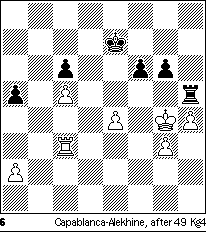
White wants to strengthen his position by Kh3 and g3-g4. How can his opponent
counter this plan?
49 ... Kf7! 50 Rc4!
In answer to 50 Kh3, Alekhine had prepared 50 ... g5! 51 Kg4 Kg6. He would
exchange the pawn on h4 and shuttle the rook back and forth on h5 and e5.
50 ... Kg7!
White's subtle maneuvers have forced the black king (who must control the
g6 square) to abandon the center. Capablanca sees that the moment has come
to transform his advantage. He gives back the extra pawn but maximally activates
his pieces and drives back the opponent's king to the edge of the board.
51 Rd4! Rxc5 52 Rd7+ Kf8
Not good is 52 ... Kh6? 53 Rf7.
53 Kf4
More accurate is 53 Ra7, because Black could now play 53 ... Rc2!?
53 ... Kg8 54 Ra7 Kf8 55 a4! Kg8 (D 7)
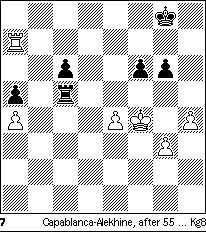
White has strengthened his position and now is ready to take decisive action.
The logical continuation of his strategy would be 56 Ke3! Rc3+ 57 Kd4 Rxg3
58 Rxa5 Kf7! (very dangerous is 58 ... Rg4 59 Ra7 Rxh4 60 a5 and with the
king cut off on the seventh rank, the passed a-pawn should decide the game)
59 Ra8 (or 59 h5). According to Alekhine Black can hold on, but in any event
he would have to defend with extreme accuracy.
Unfortunately, Capablanca didn't want to sharpen the game and chose another continuation that leads to a forced draw.
56 g4?! g5+ 57 hxg5 Rxg5!
Of course not 57 ... fxg5+ 58 Ke3-there's no reason to give his opponent
a passed pawn.
58 Ra6 Rc5 59 Ke3 Kf7 60 Kd4 Rg5 61 Rxc6 Rxg4 62 Rc5 Rg5! 1/2-1/2 (D
8)
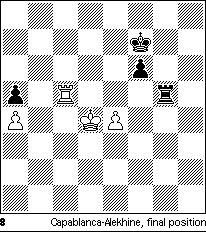
In this position a draw was agreed due to the continuation 63 Rxg5 fxg5
64 Ke5 Kg6! 65 Kd6 Kf7! (if 65 ... g4 66 e5 Black would have to defend a
queen ending) 66 Ke5 (66 e5? Ke8 and 66 Kd7 Kf6 both draw) 66 ... Kg6!
With what theme should we connect the Capablanca-Alekhine endgame? If you think it over a bit, you'll see that there is no single answer. In the process of studying this rough gem of an ending, we uncovered many facets that are all important for the practical player. Let's go over what we found.
"In this tournament I made one comforting observation, which for me was a true discovery. Namely, that although in the first game with me Capablanca outplayed me in the opening, achieved a winning position in the middlegame and preserved a significant part of his advantage in the rook ending, in the end he let victory slip from his grasp and had to satisfy himself with a draw. This led me to further thinking, taking into account that Capablanca very much wanted to win the game, as he was trying to catch Lasker, who was leading the tournament and the day before had beaten me. I was convinced that if I were in Capablanca's place, I would have brought the matter to victory without fail. In a word, I noted in my opponent a small weakness: the growth of uncertainty in the face of stubborn resistance. I had already discovered earlier that Capablanca from time to time committed minor inaccuracies, but I did not suspect that he was unable to free himself from this deficiency when he was fully concentrating his energies. This was an extraordinarily important discovery for the future!"Later, in the well-known article "The New York 1927 tournament as prologue to the battle in Buenos Aires for the world championship" which introduced his book of the tournament (see also ACJ 1, pp. 97-98), Alekhine once more underlined the role which this game with Capablanca played for him: "This game, by the way, was the starting point for my understanding of the chess individuality of Capablanca."
"... Capablanca by no means is an exceptional master of the endgame. His craft in this stage of the game is for the most part of a technical character, and other masters in a few particular areas of the ending excel or excelled him (for example, Rubinstein in rook endings)."Not all games you will find in books and magazines are as valuable as the one between Capablanca and Alekhine. But clearly, a single ending can teach many lessons.
"... In the games of Capablanca one has to notice over the years a less deep understanding of the details of a position, and the cause of this appears to be an unshakeable (I speak all the time of the period before Buenos Aires) confidence in the faultlessness of his intuition. The saddest thing for Capablanca was that his system of playing "good" moves was almost without exception sufficient, because for the most part it was opposed by positionally hopeless weapons. By going unpunished while choosing moves that were not the best, on the one hand he lost the habit of concentration during the game which is the only guarantee against the powerful forces of error, and on the other hand, his self-confidence grew to infinity and crossed almost into self-worship ..."
This article appears in ACJ 3 (1995), pp. 36-43.
Mark Dvoretsky is an international master, a professional
chess trainer, and the author or co-author of several acclaimed books (most
recently, Technique for the Tournament Player, from which this article
is adapted). He lives in Moscow.
This page last modified on
28 April 2018.
Copyright (c) 1995-2018 Christopher F. Chabris. All rights
reserved.